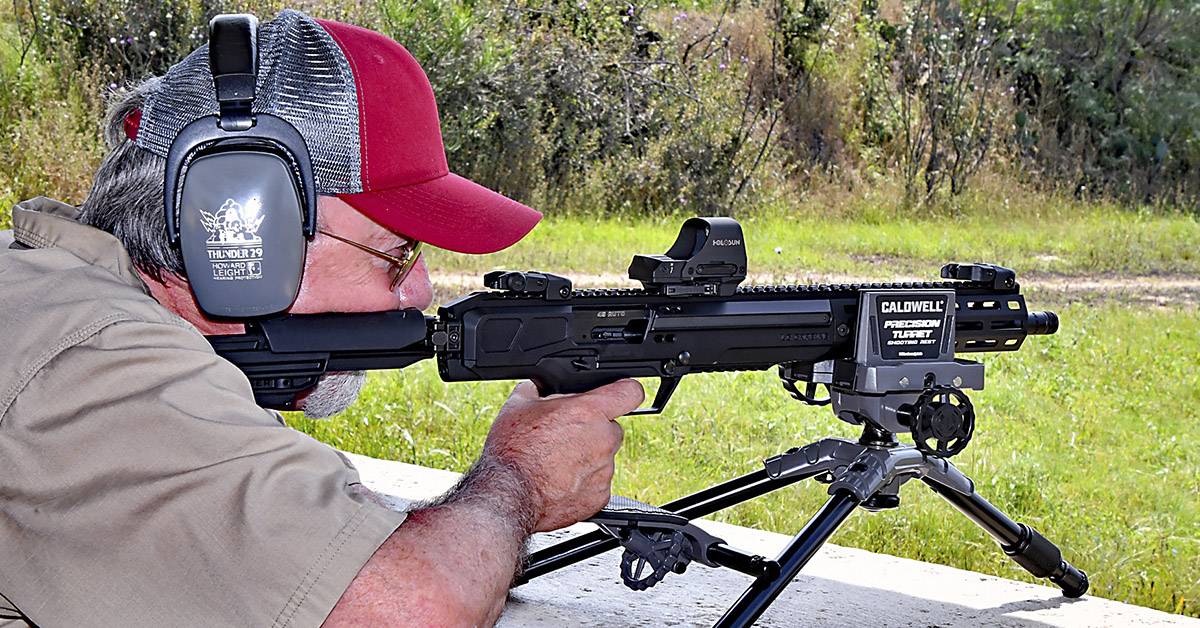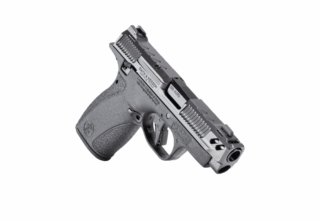Ruger has a legit contender for the best pistol caliber carbine chambered in .45 ACP
by Mike Dickerson
Some people think pistol caliber carbines are a solution in search of a problem. Why, they ask, would you use an AR-sized gun that shoots only pistol ammo?
Proponents of PCCs counter by pointing out that, compared to rifles, PCCs are cheaper to feed and have less recoil. Compared to pistols, they can provide higher velocity, flatter trajectory, greater range, and better accuracy. They’re great for running and gunning, which has led to their increasing use in competitive shooting.
No matter which side of the debate you come down on, there’s no denying that PCCs have seen a surge in popularity in recent years. Much of that is attributable to the fact that they are simply a lot of fun to shoot.
A case in point is the new Ruger LC Carbine 45, which is, as its name suggests, chambered for the .45 ACP cartridge. “LC” stands for “light and compact,” and this carbine lives up to that billing. Overall length varies between 28.5 inches, with the adjustable buttstock collapsed, to 30.6 inches with the stock fully extended. Those dimensions make the carbine useful in a home-defense role. Length with the side-folding buttstock folded against the receiver is 22.5 inches, making the gun easy to stuff in a backpack or handy as a truck gun. The folding stock is reversible and can be replaced with AR-type stocks.
Weight is 7.1 lbs. That’s not as light as some ultralight ARs, but it’s light enough for most applications. Weight savings were achieved with the use of an aluminum alloy receiver, which has a type III hard-coat anodized protective finish, and a 16.25-inch barrel. The barrel has a 1:16 RH rate of twist and is threaded .578-28 to attach suppressors, flash hiders or muzzle brakes.
The heart of the LC Carbine is its blow-back-operated, bolt-over-barrel receiver design. Some pistol caliber carbines have earned a reputation for being a bit finicky in ammo preferences and less than 100-percent reliable. I found the opposite to be true with the Ruger. It fed, fired, extracted, and ejected five different factory loads, with varying bullet weights and styles, without a single issue. The gun is rated for +P ammo, which gives the .45 ACP more punch, and it doesn’t seem to care what you feed it. This makes it a great choice for shooting suppressed.
I found this carbine to be an absolute joy to shoot. The positioning of the beefy bolt, combined with the fact that the gun feeds from GLOCK-style, full-size magazines inserted into the pistol grip, gives this gun superb balance in the hands. The pistol grip fills the hand and has ample stippling for a secure grip. Relatively mild recoil means you can run this gun fast.
The more I shot this carbine, the more I liked its ergonomics. The location and design of all controls are well thought out, but if you’re used to shooting ARs, you will need to practice instilling some muscle memory. The gun charges from a non-reciprocating charging handle on the left side of the receiver. You can switch this to the right side if you wish. An extended, ambidextrous safety is located within easy reach of the thumb. An extended bolt release is located on the left side of the receiver just forward of the safety. If you prefer, you can use a bolt release button on the right side of the receiver that you can reach with your trigger finger. It’s placed about where you would find the magazine release on an AR.
To release the magazine on this carbine, you simply slide your thumb down the top of the pistol grip a bit, hit the button, and magazines drop free. This was the hardest thing for me to get used to since I’m so accustomed to using my trigger finger to drop magazines with ARs. In keeping with the gun’s ambidextrous design, the magazine release can be switched to the right side. In that position, though, it will not work with older GLOCK magazines that have only one latch slot.
Forward of the receiver, the carbine sports a 7.5-inch CNC-machined handguard with a multitude of M-LOK attachment points for accessories. Rows of slots are located at the 1, 3, 5, 6, 7, 9, and 11 o’clock positions. One thing you will likely want to attach right away is the M-LOK QD sling socket that Ruger thoughtfully provides with each gun. (The buttstock has two QD flush cup sling mounts in place.)
Up top, you’ll find a full-length Picatinny rail for mounting optics. There’s also a short section of Picatinny rail on the bottom of the receiver immediately in front of the generously sized trigger guard. I found this to have little utility, for this is where I naturally want to place my supporting hand when shooting offhand. Placing the supporting hand on the handguard would mostly block any light or laser paced in that position. These accessories are best positioned on the handguard.
Happily, the carbine comes equipped with adjustable, folding Ruger Rapid Deploy sights. The sights can be folded down when not in use. To deploy them, you simply push a button on the side of each sight and it springs into position. The front sight is adjustable for elevation, and the rear sight is adjustable for windage by simply turning a click-adjustable wheel. In use, I found that the sights nicely co-witnessed the red dot sight I use for testing.
The gun’s fire control and safety systems deserve special mention. The carbine uses Ruger’s proven Secure Action fire-control system that employs a bladed-safety trigger and protected internal hammer. The mechanism has a neutrally balanced sear and a hammer catch to stop the hammer from hitting the firing pin unless the trigger is pulled.
I found the trigger to be much better than I expected, and a vast improvement over the MILSPEC triggers shipped with most ARs. The trigger had no creep and a short reset. It broke crisply at an average and consistent pull weight of 5 lbs., 5 oz. The wide face of the trigger and the angle of the pistol grip contributed to a consistent trigger pull.
For range testing, I used a Holosun 5510C red dot sight and a Caldwell Precision Turret shooting rest. After zeroing the gun at 25 yards, I clocked velocities for five different factory loads, using a Garmin Xero C1 Pro chronograph, to see just how much more extra speed the 16.25-inch barrel would provide over factory-stated numbers.
Velocity increases ranged from a modest 85 fps faster for a Federal American Eagle 137-gr. load to a significant 181 fps faster for a Winchester 200-gr. USA Ready Defense load. Overall, five tested loads showed an average velocity increase of 133.6 fps out of the Ruger. That may not sound like much, but it’s in line with previous testing of .45 ACP loads in 16-inch barrels. With standard loads, the old warhorse is only capable of so much velocity, regardless of barrel length, but any increase in velocity is likely to boost terminal effectiveness of 200-gr.-plus bullets.
Since the .45 ACP is a short-range cartridge, I elected to do all accuracy testing at 25 yards, which is a significantly greater distance than most home-defense engagements. The worst-performing load delivered 1.27-inch average groups and a 1.07-inch best group. The star performer was Winchester’s 200-grain USA Ready Defense load, which shot a 0.35-inch best group and 0.51-inch average groups. With my eyes, which have a bit of astigmatism, that’s about as well as I can shoot anything using a 2-MOA red dot sight.
Load / Velocity / Avg. Group Size @ 25 Yards
- Federal American Eagle 137-gr. Lead Free Ball / 1285 fps / 0.70 in.
- Browning X-Point Defense 230-gr. / 1067 fps / 1.19 in.
- Federal Train & Protect 230-gr. JHP / 980 fps / 0.64 in.
- Winchester USA Ready Defense 200-gr. JHP / 1181 fps / 0.51 in.
- Winchester Super X 230-gr. WinClean Target JSP / 1080 / 1.27 in.
That sort of performance will definitely get most any job done at the distances at which the .45 ACP is likely to be employed, especially with bullets matched to the task. I suspect the Ruger LC Carbine 45 will find favor with the legion of shooters who tend toward 1911 .45 ACP pistols as well as competitive shooters who use PCCs. It also wouldn’t be a bad choice for dispatching varmints or close-range hunting for deer and hogs, especially with tough, bonded bullets pushed at +P velocities.
In my view, the “LC” in this carbine’s name could easily stand for “Legit Contender.”
Ruger LC Carbine 45 Specifications
- Action: blow-back operated bolt-over-barrel
- Barrel: alloy steel, 16.5 in.
- Twist Rate: 1:16 RH
- Muzzle Thread: .578-28
- Finish: type III hard-coat anodized
- Stock: synthetic adjustable side-folder
- Handguard: 7.5-in. M-Lok
- Capacity: 13+1 with supplied magazine
- Front Sight: flip-up adjustable protected blade
- Rear Sight: flip-up adjustable peep
- Weight: 7.1 lbs.
- Overall Length: 30.6 in.
- Length of Pull: 12.60 in. – 14.60 in.
- Optics Mount: Picatinny rail
- MSRP: $1,009
- Hornady’s New .338 ARC: The .300 Blackout Killer? - June 2, 2025
- TESTED: Weatherby’s New Mark V Backcountry Guide Rifle - April 18, 2025
- FIELD TESTED: Weatherby’s 307 Alpine CT Rifle and Federal’s 7mm Backcountry Cartridge - January 8, 2025




















